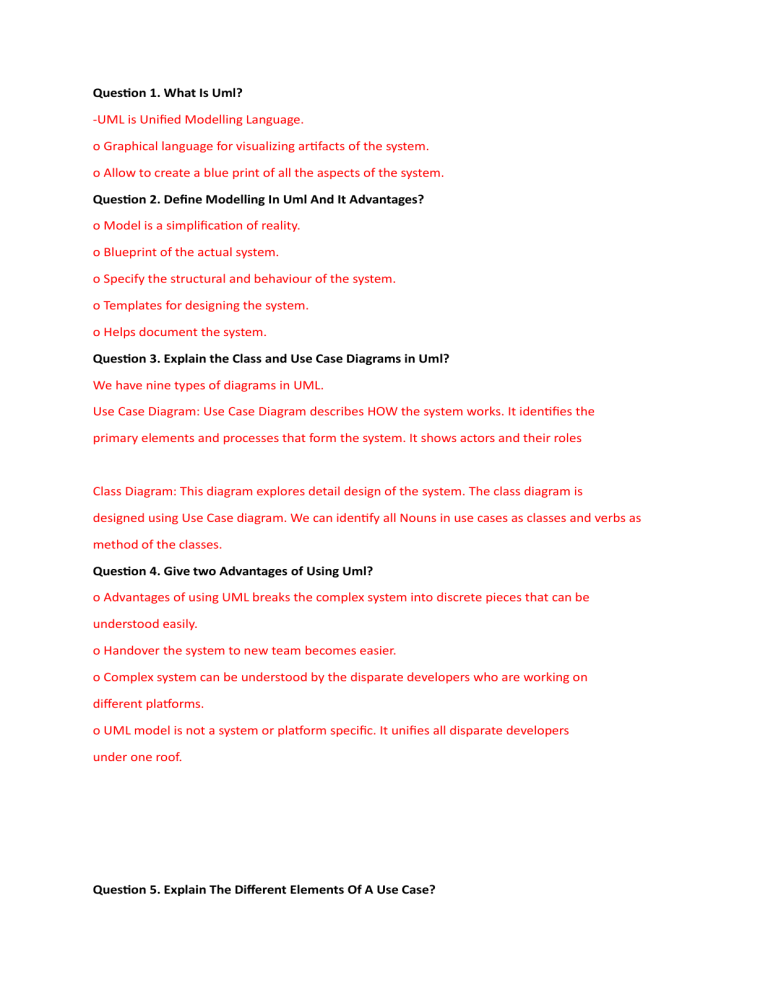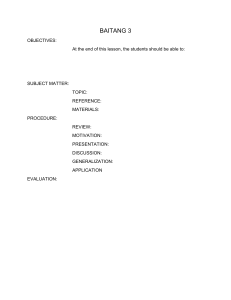
Question 1. What Is Uml? -UML is Unified Modelling Language. o Graphical language for visualizing artifacts of the system. o Allow to create a blue print of all the aspects of the system. Question 2. Define Modelling In Uml And It Advantages? o Model is a simplification of reality. o Blueprint of the actual system. o Specify the structural and behaviour of the system. o Templates for designing the system. o Helps document the system. Question 3. Explain the Class and Use Case Diagrams in Uml? We have nine types of diagrams in UML. Use Case Diagram: Use Case Diagram describes HOW the system works. It identifies the primary elements and processes that form the system. It shows actors and their roles Class Diagram: This diagram explores detail design of the system. The class diagram is designed using Use Case diagram. We can identify all Nouns in use cases as classes and verbs as method of the classes. Question 4. Give two Advantages of Using Uml? o Advantages of using UML breaks the complex system into discrete pieces that can be understood easily. o Handover the system to new team becomes easier. o Complex system can be understood by the disparate developers who are working on different platforms. o UML model is not a system or platform specific. It unifies all disparate developers under one roof. Question 5. Explain The Different Elements Of A Use Case? Use case diagram is a subset of various behaviour diagrams. Use case diagrams are used to provide concrete examples of the elements which are supposed to implement. It is used to analyze objects. The following are the elements of the use case diagrams: Actors: An actor is one of the entities who perform certain actions. These roles are the actual business roles of the users in given system. An actor interacts with a use case of the system. For example, for a banking system, a customer is one of the actors. Use Case: A use case is a use case diagram of UML represents a business functionality that is distinct. The use case should list the discrete business functionality that is specified in the problem statement. Every business functionality is a potential use case. System boundary: A system boundary defines the scope of the system. The systems that use cases also need to be defined in the limits of the system. The system boundary is shown as a rectangle that spans all use cases of the system. Question 6. Explain The Meaning Of Association? There are five types of association but importance is given to only two they are Bidirectional and unidirectional. It represents a family of links. Binary associations are represented by two ends and they are connected to class box. Higher order associations can have more than two ends. Question 7. Difference between Inception and Elaboration? Elaboration focuses requirements capture and determining the structure of the system. Inception is concerned with determining the scope and purpose of the project. Question 8. What Is Generalization and Specialization? Generalization: Generalization is the abstraction of common feature among elements by the creation of a hierarchy of more general elements that encapsulate common features. For example, in animal world a cat and a dog share some common features and we create a common general class “Mammal” which encapsulates common their common feature. A cat, a dog – both are consistent with mammal class. Specialization: The other face of generalization is specialization. A class is said to be specialized when it has a set of characteristics that uniquely distinguish it from its super class. For example, a cat is a mammal but it is more specialized. Question 9. Explain Functional and Non-functional Requirement? Functional requirements describe what a system does or is expected to do, often referred to as its functionality. Non-functionality requirements are those that describe aspects of the system that are concerned with how well it provides the functional requirements. Question 10. What Are Attributes? An element of the data structure that, together with operations, defines a class. Describes some property of instances of the class. Question 11. What Is Multiplicity? Multiplicity is a constraint that specifies the range of permitted cardinalities, for example in an association role or in a composite class. Question 12. What Is Composition and Aggregation? A strong form of aggregation with a lifetime dependency between each part and the whole. No part can belong to more than one composition at a time, and if the composite whole is deleted its parts are deleted with it. A whole–part association between two or more objects, where one represents the whole and the others parts of that whole. Lab Draw an ER diagram (c) use case for Patient Record and schedule system.


